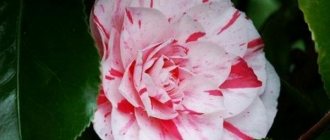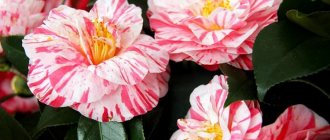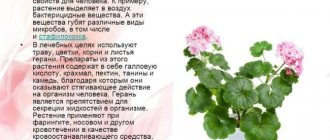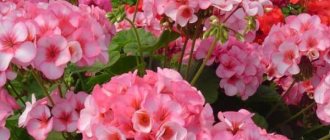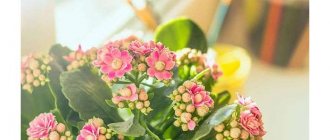Many people are familiar with a beautifully flowering indoor plant that resembles a rose. But unlike a rose, it has no thorns, and the leaves are shiny and glossy. We'll talk about camellia. The plant, which grows in countries with tropical climates, has taken its rightful place on the windowsills of our apartments and is very popular. In this article you will find useful information about growing and caring for camellias at home.
Botanical description
Camellias are medium-sized, evergreen, tree-like shrubs. They belong to the Tea family. Distributed in Japan, China, Korea, and the Philippines.
Camellias grow well in humid climates, in mountainous areas and are not afraid of short frosts down to -15°C.
In this case, the acceptable summer temperature should not exceed +25°C .
In other cases, it is grown as a houseplant. The leaves of the plant are simple oval in shape, strong and glossy. The flowers resemble roses or peonies. In most species, the flowers have no scent. Large, double flowers are arranged singly on the branches. Color range from white to red. An amazing feature of camellia is its long flowering period when dormant.
It begins to grow actively after flowering ends. This process begins in March - April.
Lighting
Camellia prefers bright, but diffused lighting. It is optimal to place camellia on an eastern or western windowsill.
On the south window you will need shading from the midday sun.
It is periodically recommended to rotate the plant around its axis to form a symmetrical crown.
However, during the period of bud formation and flowering, the pot cannot be moved - this can lead to the buds and flowers falling off.
In the warm season, non-blooming Japanese roses can be taken out into the open air. It is important to place it in partial shade to avoid leaf burns. In winter, when there is little natural light, additional lighting with fluorescent or phytolamps will be needed. Camellias need to be provided with a 12-14 hour day.
Varieties and photos
Currently, about 200 species are known. Let's look at the most popular ones. Below are photos, names and descriptions of camellia varieties suitable for propagation and care at home:
Mountain
It is a shrub up to 5 m in height. It blooms with flowers up to 7 cm in diameter. Flowering from November to January. The color of the flowers, depending on the variety, is white, pink and red. Flowering is very long : from November to January. When grown indoors, camellia growth is easily regulated by pruning branches.
Among the best varieties of mountain camellia are: “White Double” with double, white buds and “Inishi” with pink flowers, strong double buds. The photo below shows Camellia Mountain:
Chinese
Chinese camellia or Chinese tea rose loves air temperatures from +18°C to +25°C. In winter, the optimal temperature is +10°C. This unpretentious plant can withstand frosts down to -22°C. Excellent for shaping and decorating the crown. Chinese camellia blooms from August to October. Unlike other species, the Chinese “beauty” blooms with fragrant flowers. The flowers are white or yellowish in color.
Green tea is made from camellia chinensis. I widely use it in oriental and folk medicine. Camellia sinensis leaves have bactericidal properties.
Japanese
Japanese camellia is a tree-like shrub that in natural conditions grows up to 10 meters in height. Blooms from November to May , with double and semi-double flowers up to 5 cm in diameter. Japanese camellia can be grown both outdoors and indoors or in greenhouses. The leaves are oval-shaped, quite large: they can reach 10 cm in length. Dense and leathery, with a glossy surface, the leaves have a very decorative appearance.
Selected varieties of Japanese camellia can have not only monochromatic, but also variegated flower colors. In addition, some varieties have flowers collected in inflorescences.
The variety “Alba” is distinguished, blooming with white, simple buds; “Winter Rose”, the flowers of which are white or pink and are double; "Buttermint" with white flowers; "Lavinia Maggie" with variegated flowers. You can see what the Camellia Japonica variety looks like in the photo below:
Lady Campbell
'Lady Campbell' is a Japanese species of camellia. The compact bush grows up to 2 meters. The flowers reach 10 cm in diameter, the colors are scarlet with a pink tint. Long flowering from August to November . In the southern regions it can be grown not only as an indoor plant, but also in open ground. In regions with harsh winters it is grown as a pot plant. In the photo below is the Camellia Lady Campbell variety:
What is camellia - a brief botanical information
The evergreen beautifully flowering camellia belongs to the Tea family. The plant is native to the tropics of the East and subtropics of Southeast Asia. In nature, the flower is a shrub or small tree with a loose crown growing up to several meters. They named it in honor of Camellus, who first discovered this plant and brought it to Europe from the Philippines.
The dark green leaves are round in shape and arranged singly or in pairs. The flowers are large and, depending on the variety, colored red, pink, snow-white or variegated. Flowering occurs in winter and lasts until mid-spring.
Camellia can bloom even in the winter season
How to care?
Like any plant, camellia needs quality care at home.
Lighting
In nature, camellias grow in the undergrowth, which means they require diffused sunlight. For successful cultivation, it needs to create conditions similar to natural ones.
Temperature
Camellias overwinter at low positive temperatures from 0 to +5°C. In summer they prefer humid air heated to +25°C. During the flowering period, a temperature of no higher than 12-15 degrees Celsius is required. And after flowering, during the period of active growth, keep the temperature within +20°C. From July to August, camellia begins to lay buds, at which time it needs heat no more than +25°C.
Direct sunlight may cause dry, brown spots to appear on camellia leaves.
Humidity and watering
During flowering, water in small quantities.
This is due to the fact that camellia blooms at rest. And it doesn't require a lot of moisture. After flowering has ended, watering is increased, as the camellia begins to actively grow. At this time, the earthen coma should not be allowed to dry out . During the period of bud formation, moderate watering is needed. This is done in order to improve the quality of the buds.
From excessive watering, camellia leaves develop brown spots and swellings.
For irrigation you need to use soft or rain water. Or ordinary water, which has been left for at least three days with the addition of a few drops of lemon juice.
Top dressing
Complex formulations for azaleas are used for feeding and fertilizing. In winter, the flower does not need feeding. Fertilizers should be applied during the period of active growth. It is enough to fertilize camellia twice a month.
Transfer
Camellia is transplanted during the dormant period or in the flowering state. The best time is late February - early March . The container for replanting should be no more than 1-2 cm in diameter larger than the previous one. Before planting the bush in a new pot, you need to carefully straighten the roots. This is done for better rooting and growth.
A flower pot or other container for planting must have drainage holes. A drainage 2-3 cm thick is laid at the bottom. Expanded clay, broken clay or ceramic shards are used as drainage.
Additionally, you need to sprinkle a small layer of coarse river sand on top. Plastic flower pots are great for camellias because they do not evaporate moisture. There should be only one drainage hole in the container.
What kind of land is needed?
Camellia prefers light, acidic soils.
Soil acidity is from 4-5.5 ph. A ready-made soil substrate for azaleas and rhododendron mixed with rotted pine needles is well suited. When planting, you need to pay special attention to the root collar of the plant. It cannot be buried in the ground.
Trimming
Growing in open ground, do not need pruning. Unless the owner of the plant decides to give the shrub a more decorative appearance. Camellias are great for crown formation.
If the bush grows in a pot and gains a lot of green mass, it becomes difficult for the roots to support the entire plant and this may affect the quality of flowering. In this case, it is recommended to prune the plant and give it the opportunity for abundant and lush flowering.
Pruning is carried out after the end of growth from the end of June.
Subtleties of care
Camellia is one of the plants that requires certain conditions to be successfully grown. Therefore, let's talk about how to grow camellia in city apartments and make it bloom. When you see a flowering plant on sale, you feel the desire to purchase a luxurious flower. But often such a purchase ends in the death of the plant after flowering ends.
Creating a comfortable temperature regime
The most important thing is to ensure temperature conditions, because for normal development a flower needs conditions close to natural. For flowering in winter, camellia is recommended to be kept at a temperature of 10-15 degrees. It can withstand slight sub-zero temperatures. It is impossible to maintain coolness in an apartment with central heating. But if you have a glazed, insulated loggia, balcony or cool veranda in a private house, then you can admire the flowering plant all winter. In summer, camellia prefers moderate temperatures in the range of 20-25 degrees.
Camellia is demanding on lighting, so with short daylight hours it is necessary to provide it with additional lighting. As a result, daylight hours should reach twelve to fourteen hours. When placing a flower on a window facing south, you need to take care to protect it from direct sunlight and moisturize it. The most suitable would be an eastern or western window, where the camellia is not threatened by the hot midday sun. On a window facing north, the plant shreds and stretches out.
This may be interesting: Methods of propagation of Streptocarpus
Watering, moistening and fertilizing
Camellia is one of the flowers that begins to grow shoots in the spring. At the beginning of autumn, buds are laid and flowering occurs in winter. Therefore, watering and the application of mineral fertilizers must be organized taking into account the annual growth cycle. Camellia needs bottom watering through a tray, draining the remaining water after an hour and a half.
In the spring, when new shoots begin to grow, and in the summer, camellias need to be watered frequently and abundantly. But the soil should not be allowed to become waterlogged, because this will lead to rotting of the roots. In winter, watering is reduced to once a week. Camellias are harmed by an increase in calcium salts in the soil, so the water must be settled. You can use melted or boiled water. Sometimes it is recommended to add a small amount of vinegar or citric acid to the water to increase the acidity of the soil.
Camellia needs air humidification, especially if the pot with the plant remains in the apartment for the winter. Hot radiators dry out the air greatly, which can lead to buds and leaves falling off. Therefore, the foliage is periodically sprayed without moistening the soil. You can place the pot in a tray with damp expanded clay or moss. If possible, we recommend installing a humidifier, which will create a comfortable microclimate not only for the flower, but also for people.
In the spring, when young shoots begin to grow, you can start feeding camellias. To do this, use fertilizers for azaleas. The amount indicated on the package is halved. Fertilize no more than 1-2 times a month. In July, fertilization is stopped until next spring. When choosing fertilizers, you should pay attention to ensure that they do not contain calcium and magnesium. Excess calcium in the soil causes buds to fall off.
Crown formation
In order to give a compact shape and remove weak shoots, camellias are pruned. This procedure is performed at the end of flowering. After pruning, the plant produces new shoots more actively. Flower growers who have been growing camellia for many years already know how many shoots need to be left so as not to weaken the bush with abundant flowering.
By cutting shoots, you can form a bush or tree. After pruning, the cut of large woody branches is treated with garden varnish. It is permissible to trim shoots to half their length.
Important! During the formation of buds, we do not recommend rearranging or turning the pot, otherwise the plant may drop the buds.
Reproduction
Gardeners have many questions about propagating camellias at home. There's really nothing complicated. Let's look at methods that even novice plant growers can handle.
Cuttings
Cuttings are carried out from June, when the camellia growth period is over, the shoots have matured and become half lignified. Take cuttings with 4-5 leaves . Remove the lowest leaf and make an oblique cut under the node. The remaining leaves can be cut in half to reduce evaporation.
The cut of the cutting must be treated with “Kornevin” and placed in a container with river sand or river sand mixed with peat.
For better rooting of cuttings, high humidity is needed. To achieve this, you need to place the cutting together with the container under a plastic cap or make a structure from polyethylene. For rooting, cuttings are placed in a warm place with an air temperature of 20-25°C. The rooting process of camellia is very long and takes more than 2 months. But at the same time, this method of propagation will preserve the variety of the plant.
From seeds
The seed method of camellia propagation takes a very long time. A plant grown from a seed will begin to bloom only in its fifth year. Propagation by seeds does not guarantee the preservation of the maternal characteristics of the variety.
Expert opinion
Vera Ivanovna Sh
Since childhood, I have been interested in growing indoor flowers, then I decided to devote my life to landscape design and gardening.
Camellia seeds are sown immediately after ripening, before winter. Once the seed pod has opened, the seeds are ready for sowing. They are sown in a mixture of river sand and peat. And put in a warm place up to +25°C. After the sprout appears, the container is moved to a shaded place while maintaining the temperature regime. When the sprouts reach 7-10 cm, they can be transplanted into a pot with a larger diameter. The composition of the soil remains the same.
If the seeds were purchased in a store, they should be stored in the refrigerator until planting. Before planting , the seeds are soaked for several days. And then, since the seed shell is very hard, you need to make a hole in it to speed up the germination of the plant.
Offspring
The easiest way to propagate Camellia is by root suckers. As the mature plant grows, it may develop side shoots. When they reach acceptable growth, they are carefully separated from the mother root and planted in a separate pot. Then they grow and care for them in accordance with the requirements.
Vaccination
Experienced gardeners propagate camellia by grafting. This method is used to propagate selected varieties that are difficult to propagate by seeds and cuttings.
For the grafting method, you need to take sprouted sprouts of at least 5 cm. The top of the sprout is cut off and split. A pre-prepared camellia cutting is inserted into the cut site and needs to be rooted.
The sprout is planted in a mixture of peat and river sand . The pot is placed in a plastic bag and ventilated as condensation accumulates. The place should be warm and dark. There should be no drafts or direct sunlight. The grafting site is wrapped so that the cutting does not fall out or move. It is best to use some kind of breathable material, gauze or cotton strip. And secure the bandage on top with an adhesive plaster. But under no circumstances should adhesive tape or tape be used.
The graft should not be unwound often for inspection, as there is a risk of damaging it. The first examination can be carried out after 2-3 months. And the bandage can be completely removed no earlier than after 6-8 months.
Whether the graft has taken root or not will be clearly visible from the state of the sprout. If at first it is weak, perhaps completely shedding its leaves, then as the grafting takes root, the appearance of the plant will improve.
The grafting method is quite complicated for beginners. But it makes it possible to combine the advantages of seed and cutting methods of camellia propagation. When grown from seed, it takes a long time before the bush begins to bloom. And cuttings do not give a high percentage of rooting, but there is a guarantee of the safety of the variety. By combining these two methods, you can achieve success in reproduction.
Conditions for growing camellias and care at home
If you describe the characteristics of the camellia flower, indicating that the plant can withstand frosts down to –5 °C, blooms at +10 °C, has almost no dormant period and is incredibly decorative almost all year round, you might think that there is no better crop for your home collection. But that's not true. The difficulty of keeping camellia is that creating such conditions in an apartment is extremely difficult.
Without a bright, closed balcony, loggia, terrace or winter garden, it is unlikely that you will be able to enjoy camellia blooms, because the plant’s buds open in the winter, and the growth of greenery begins with the arrival of spring.
How to care for camellia at home? Throughout the year, camellia needs up to 12–14 hours of daylight, but does not react well to direct sunlight. Therefore, on southern windows in the summer, the shrubs are provided with shading. But on the north side the plant will be completely uncomfortable, which is signaled by elongated shoots, pale and shredded foliage. With the decrease in natural light when autumn comes, camellias are provided with artificial lighting.
If in spring and summer camellias are kept at room temperature, then with the onset of autumn it will be harmful for the plant to be in a warm room. It is transferred to a glazed loggia or an insulated balcony, terrace or other place where the temperature will be about 12–15 °C.
With proper care and maintenance, a camellia flower, as in the photo, will produce many buds, and flowering will begin in winter, continuing even at low sub-zero temperatures down to –10 °C.
Diseases and pests
Indoor camellias are susceptible to diseases and pest attacks. The main measure to prevent disease is to keep it away from other plants. And strict adherence to care rules.
Why do the leaves turn black?
Camellia leaves turn black as a result of excessive soil moisture. This plant does not like stagnant moisture. Therefore, it needs to be watered when the top soil dries 2-3 cm. If, nevertheless, the plant was flooded and the leaves began to turn black, the following measures should be taken:
- Trim affected branches back to healthy matter.
- Transplant into another container, changing the drainage and soil.
- When replanting, inspect the root system and remove damaged roots. They will be dark in color.
Also, the causes of darkening of the leaves may be a disease. For example, phyllostictyosis. In case of fungal diseases, you need to remove the affected areas of the plant and treat the bush with a solution of “Bordeaux mixture” or “copper sulfate”.
Why do the leaves fall?
Camellia can shed its leaves if it is stressed.
Flooding the soil with water, a draft, moving it to a new place, drying out the earthen coma, lack of lighting - all these reasons can lead to the loss of leaves and shedding of buds. To help the plant, you need to create optimal conditions for it to grow. It may be necessary to fertilize with mineral fertilizers . It is best to use complex fertilizers for azaleas.
You can try a home remedy, such as using dried and crushed banana peels and eggshells to feed the plant.
Spider mite
Dry air and too warm temperatures cause spider mites to appear. To combat this pest, oil aerosols are used. Or you can use a soap solution if the plant is not severely affected. Prepare a solution from soft water and laundry soap. If there is a large number of pests, it is better to use Fitoferm preparations and others.
Mealybug
Mealybug larvae are easy to see on the plant. Damaged leaves are cut off along with the larvae. And the whole plant is treated with a solution of “karbofos”. Dilute the drug per 1 liter of water with 20-40 drops.
Transfer
Camellias are transplanted from November to February.
Young specimens are replanted annually, adults - as needed, when the pot becomes too crowded.
During transplantation, the tips of the shoots are pinched for better branching.
Camellias prefer wide pots . The plant should not be deeply buried - the root collar should be above ground level.
The optimal way to transplant camellias is to transfer them together with a lump of earth into a new pot. Thus, the likelihood of damage to the root system is significantly reduced.
If the time of transplantation coincides with the camellia flowering, then the procedure should not be postponed. The plant tolerates replanting well even during flowering; it will not shed either buds or even open flowers.
It is better not to replant the plant in spring, as active growth and development begins at this time. And a transplant can significantly slow down this process.
Photo gallery
Flower varieties
In total, there are about two hundred and fifty varieties of camellia.
Camellia japonica
This bush is called the most popular among all varieties. Its height reaches one and a half meters. At the same time, you can find varieties that grow up to six meters. These are already whole trees.
The flowering period begins in late autumn - in November, and ends in May. At this time, the tree is covered with large bright flowers. They are located between the leaves of a dark green hue.
A plant can be more than just a decorative element. For example, in Asia, camellia is part of a complex treatment against complex cancer.
There are the following varieties:
- Alba. This is a white camellia. Her flowers are beautiful, but quite simple.
- Winter rose. This plant has double flowers. They are usually whitish or pink in color.
- Camellia sinensis. This type is most often used in preparing tea drinks. This is a perennial that can reach ten meters in height. Its distinctive feature is spreading branches and dark green leaves, the length of which varies from five to seven centimeters.
During the flowering period, buds appear that emit aroma. They are usually pale yellow, milky cream or white. The size of the corolla varies from two and a half centimeters to three.
Camellia sasanqua (mountain)
The height reaches two and a half to three meters. The branches of the bush are flexible at first. Gradually they become lignified. And the edge changes to brown-green bark.
The leaves are located on short petioles. The flowers have practically no peduncle. The buds are often located singly. Another option is in groups of three flowers.
In most cases, the buds are pinkish or whitish. However, you can also find red flowers.
Several more have been bred from this species. They are cold-resistant. They do not have strict growing requirements. Therefore, they are kept even in temperate climates.
There are the following varieties:
- Bicolor. Their peculiarity is in the petals, along the edges of which there is a stripe of a purple hue.
- Chansonnier. This species has double delicate flowers. Usually their shade is close to pink.
- Cleopatra. The flowers of this bush have fairly simple corollas. The petals are approximately the same color as those of the previous species.
Problems during cultivation and their elimination
Frequently encountered problems when growing indoor Camellia and ways to solve them:
| Problem | Causes | Solution |
| Brown spots on leaves | Sunburn | Move the flowerpot to partial shade |
| Scanty flowering | Soil acidification, application of fertilizers with calcium and magnesium | Water the plant only with soft water, do not overwater the bush, select suitable fertilizers for feeding |
| Yellowing and falling leaves | Lack or excess of moisture, nutritional deficiencies | Regularly fertilize camellia, normalize the watering regime |
Possible problems
When caring for camellias, even the most experienced gardener may encounter problems such as:
- falling of buds and flowers - due to excessive soil moisture;
- the appearance of brown spots on the leaves - with strong exposure to sunlight;
- leaf fall - due to lack of humidity;
- camellia does not bloom - due to lack of light;
- the plant sheds buds when the room is dry;
- death of the plant - if the rules of care are not followed (untimely watering, lack of light, unsuitable soil, low humidity level).
Note!
Camellia is a poisonous plant, so replanting, pruning and other procedures related to its care should be carried out only with rubber gloves.



